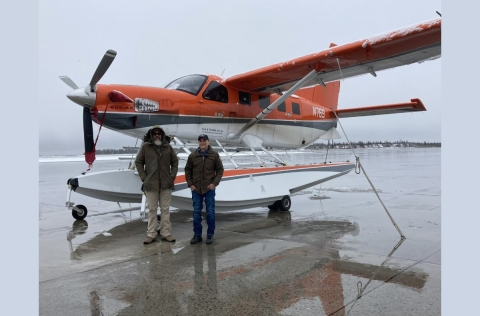My survey crew area includes Maine and the Atlantic Canada provinces of New Brunswick, Nova Scotia, Prince Edward Island, and Newfoundland/Labrador. This survey area, while offering some stunning views and amazing scenery often also comes with very poor flying weather. However, my observer, and retired pilot-biologist, John Bidwell, and I had a promising start in Maine in early May and, after four days of near perfect weather and perfect timing with respect to waterfowl breeding, we had finished the state. Coming off two consecutive years of abnormally dry conditions in Maine, habitat conditions looked good. While down for a scheduled aircraft inspection after finishing Maine, a personal issue required that John return home. Thankfully, Refuge Manager, Pat Stinson, was able to step in and continue the survey with me. The transition caused a delay of about a week after which Pat and I were at it again, pushing hard through the Maritime provinces of New Brunswick, Prince Edward Island, and Nova Scotia to avoid missing the critical, and relatively short, egg-laying and nesting periods that the survey timing is based on. We, again, enjoyed some uncharacteristically good weather and completed this region quickly. Habitat conditions in the Maritimes, like Maine, had improved following several dry years.
After a weather delay in Halifax, Nova Scotia, we made the trek across the Gulf of St. Lawrence to Stephenville in southwest Newfoundland. In most years, we are lucky to fly one day out of four in Newfoundland but, once again pressure systems aligned to allow us to make quick work of the “Rock” and four days later we were in Goose Bay, Labrador with just three survey days left…and that is where our luck ran out as an atmospheric block locked pressures systems in place and funneled low clouds, cold temps and both rain and snow for days on end. As I write this on June 1, we’ve been sitting 5 days and today it’s snowing hard and sideways. It’s just a waiting game now for better survey weather as the coastal low pressure drifts glacially to the south and east.
Newfoundland, and especially Labrador, received a tremendous amount of snow this past winter and the spring was substantially delayed, especially in Labrador. Rivers, creeks, and wetlands in northern Newfoundland and many parts of Labrador were as high as I’ve seen them in my 12 years surveying this area. Parts of Labrador, especially the southeast coast and northern portions of the crew area, were still locked in winter. Interior Labrador wetlands and lakes were open and harbored good populations of waterfowl.
After a month now of surveying, we’re eager to continue and return home. Each year the return to Maine is always a big transition as we’ve followed winter north during the survey and then return to full blown summer. I’m blessed to get to experience such an inspiring landscape every year, and to see areas and scenery that few, even locals, will ever experience. However, I’m always profoundly grateful when our crew and all the other crews operating across the continent have returned home safely for another year.






